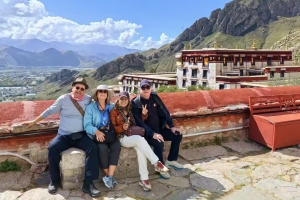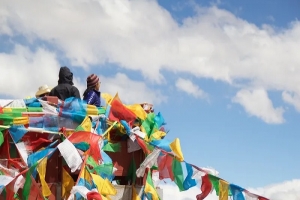Crimson Snow
While snow is often associated with a pristine white blanket, nature occasionally surprises us, as seen with red snow in Tibet. A group of climbers ventured into the stunning yet challenging heights of the Himalayas, where they stumbled upon striking patches of red snow at elevations surpassing 5,000 meters. This vivid and unusual sight adds colour to the icy landscape, drawing attention as one of the region’s most intriguing occurrences.

Crimson Snow
So, what causes this striking red hue? The answer lies in tiny, resilient organisms known as snow algae. These remarkable algae have adapted to thrive in extreme cold, making the frigid Himalayan climate their ideal home. They contain special pigments that enhance their ability to absorb sunlight. Their vibrant red comes to life when they soak up more light than usual. This captivating transformation paints the snow with unusual shades. It highlights the incredible adaptations of life in even the harshest conditions.
Blighted Lake
Nestled in the breathtaking landscapes of Tibet, La’angcuo, also known as Lake Rakshastal and Manasarovar Lake, lie gracefully side by side, extending from east to west like two shimmering gems. Legend has it that long ago, these two lakes were connected, flowing into one another. However, the waters receded as time passed, leading to their separation and their two identities today.

Lakeside of La’angcuo
Manasarovar Lake is a serene oasis, often celebrated for its crystal-clear waters that glisten under the expansive blue sky. Many describe its waters as sweet and refreshing, inviting travellers to bask in its tranquillity. In stark contrast, La’angcuo presents a strikingly different atmosphere with its tumultuous and deep salty waters. Often shrouded in a blanket of dark, brooding clouds, the lake has earned its haunting nickname, “Ghost Lake,” due to its eerie ambience and unpredictable nature. The stark contrast between these two lakes is a wonder to behold.
La’angcuo is classified as an inner lake, meaning it lacks an outlet to the ocean, which adds to its mystique. A thin stream connects it to the more tranquil Manasarovar Lake, highlighting their shared history. Dominating the landscape is the towering Namu Nani Peak, which stands proudly by the lakeside. Its majestic presence enhances the region’s awe-inspiring scenery.
In 1906, Swedish geographers explored La’angcuo, eager to chart its depths. However, they could only measure a portion of the northern end before their efforts came to a halt, leaving the full depth of this enigmatic lake an unanswered question that still captivates adventurers and scientists alike.
Overnight Disappeared Kingdom
More than a thousand years ago, an extraordinary civilization thrived alongside the winding waters of the Xiangquan River, located about 18 kilometres from Zhada County in the picturesque region of Tibet. This vibrant culture flourished until approximately 300 years ago, when it vanished without a trace, leaving behind ancient ruins that whisper tales of its rich artistic and cultural accomplishments.

Remains of Guge Kingdom
Today, ongoing archaeological digs are unearthing a treasure trove of remarkable artefacts, including exquisite gold and silver Buddha statues and intricately designed scriptures that reflect the sophistication of the Guge civilization. Among these findings, the Guge Silver Eye, a large silver disc with a central eye motif, is a breathtaking artefact. It is believed to have been a symbol of the Guge kings’ divine right to rule, captivating all who encounter it with its brilliance and historical significance.
Surrounded by dense earth forests, the remnants of the Guge Kingdom reveal structures built from mud sourced from the local terrain, allowing them to harmonize beautifully with the natural landscape. As the sun begins to set, the ancient city transforms into a magical sight, bathed in warm hues of orange and pink, evoking a sense of wonder as its historical legacy merges with the breathtaking beauty of nature.
The reasons behind the sudden disappearance of this once-thriving civilization remain shrouded in mystery. Various theories abound, suggesting possibilities such as migration to more prosperous regions, devastating diseases, catastrophic natural events, or conflicts driven by human activities. Some historians believe that the Guge civilization may have fallen victim to a combination of these factors, leading to its eventual demise. These intriguing remnants continue to spark curiosity and invite exploration, drawing historians and adventurers alike to uncover the secrets of the past.
Undecayed Remain
The Xiazhulin Temple, gracefully perched beside the winding Yarlung Zangbo River, captures the eye with its charming architecture that resembles a miniature version of the grand Potala Palace from a distance. The temple, built in the 11th century, is a significant cultural and religious site in Tibet, housing a collection of ancient scriptures and artefacts. As you ascend to the temple’s summit, you’re greeted by a breathtaking panorama of the river’s tributaries, meandering through the lush landscape below.

Goddess of Good Fortune
Upon entering the temple, a serene atmosphere envelops you. Walking along the corridor, you reach the end, where a gentle left turn leads you into a dimly lit hall. Here, an extraordinary sight awaits—the meticulously preserved body of a twelve-year-old girl who has been in this remarkable state for a millennium. Local traditions hold her in high esteem, believing she is the incarnation of the Goddess of Good Fortune, drawing devotees who come to pay their respects.
Her tiny body, now shrunk to the size of an elbow, presents a hauntingly beautiful image. One of her eyes appears as if caught in a delicate balance between slumber and wakefulness, giving her a mystical presence. This preservation is particularly significant within Tibetan Buddhism; she is among the few females to have endured for such an extensive period. Seated in a tranquil position, the girl embodies the spiritual essence of the Xiazhulin Temple, a sacred site devoted to reverence and awe.
Shambhala
Shambhala, which means “holding happiness,” is intricately linked to the Buddhist concept of Kalachakra, which represents the cycle of time and the universe. According to ancient Tibetan legends, Shambhala is depicted as a hidden, mystical kingdom shrouded in secrecy in a vast, icy expanse north of Tibet. This enchanting realm is said to be inhabited by people who embody a remarkable spiritual enlightenment, free from the burdens of obsession, confusion, and desire.

Thangka of Shambhala
Tibetan scriptures narrate that after the passing of Sakyamuni, the founder of Buddhism, the profound and secret Kalachakra teachings were entrusted to Suchandra, the very first emperor of this legendary land. Historical research suggests that the roots of these teachings can be traced back to India in the 10th century AD. Still, they were also deeply intertwined with the cultural and spiritual heritage of Tibet and the concept of Shambhala. Over time, Shambhala became recognized as a pure land within Tibetan Buddhism, symbolizing a place of ideal spiritual practice and harmony. Yet, despite its rich narrative and spiritual significance, the actual existence of Shambhala continues to be a compelling mystery, leaving many to wonder about the truths hidden within its legend.










